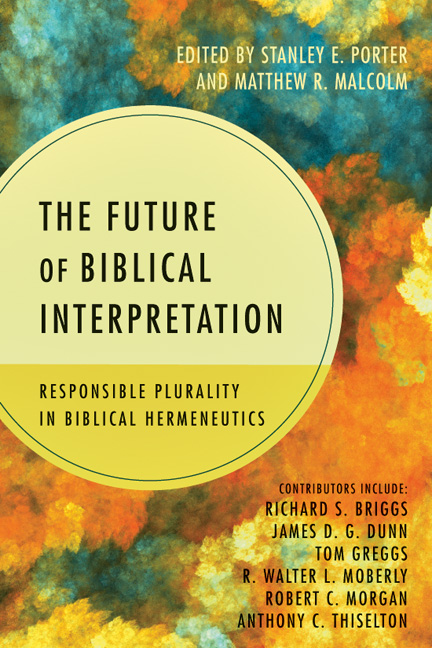The Future of Biblical Interpretation: Responsible Plurality in Biblical Hermeneutics, is a collection of essays initially presented at a conference held at the University of Nottingham in honor of Anthony Thiselton. The volume offers an impressive line-up of contributors, including: Anthony Thiselton, Stanley Porter, Richard Briggs, Matthew Malcolm, James Dunn, Robert Morgan, Tom Greggs, and Walter Moberly. For the sake of economy, I have selected a cross section of the essays for closer attention, beginning, for obvious reasons, with Thiselton.
In the opening essay, “The Future of Biblical Interpretation and Responsible Plurality in Hermeneutics,” Thiselton presents a model for engaging with plurality in hermeneutics. He begins by outlining several approaches that have been used to create unity out of the pluriform biblical texts (13-17). Then, he moves to consider the work of Mikhail Bakhtin, whom he believes provides the best approach for addressing the question. According to Thiselton, Bakhtin advocates “polyphonic meaning” rather than “pluralism,” and prefers “concordance” over “unity” (18). The attraction to Bakhtin’s model is that it allows each of the biblical texts to speak with their own voices from their own worlds, in conversation with one another (20-1). Thiselton argues that this does not lead to inherent contradictions, because “the interaction between these voices can never be finalized.” (21). The emphasis, then, is on a biblical hermeneutics that is both an open and creative endeavor, as well as a task that is always “rooted in specific biblical texts” (25).
Stanley Porter’s essay, “Biblical Hermeneutics and Theological Responsibility,” engages with questions surrounding the wider functions of hermeneutics. A large portion of the chapter is devoted to distinguishing between “theological hermeneutics” and “theological interpretation” (37). For Porter, theological hermeneutics is a broader philosophical-theological endeavor (38-9). Theological interpretation, on the other hand, is a reactionary method, which unreflectively privileges premodern and precritical exegesis, “simply because it is premodern and precritical” (40-44). Porter believes that this type of theological interpretation stunts the hermeneutical task, and thus, “is not the way forward in developing theological responsibility in biblical hermeneutics” (46). He advocates an approach that remains responsible to tradition without stripping premodern interpreters “of their historical, temporal and sociopolitical embeddedness” (48).
Robert Morgan’s essay, “Biblical Hermeneutics and Critical Responsibility,” focuses on the role of critical biblical scholarship as a theological enterprise. For Morgan, many critical scholars rightly “see themselves as historical theologians and exegetes, not merely historians of theology and grammarians” (109, his emphasis). This, of course, has been met with resistance by some: “…some Bible-believing Christians [prefer] to limit themselves to an explicit theological interpretation informed by a historical research which knows its limits and does not become an instrument of theological criticism” (110). Morgan combats this position by illustrating ways in which historical Jesus research has served as a rich, theological exercise (111-114). He concludes by asserting, “[d]oing theological criticism through historical criticism in complete New Testament theologies reduces the risk of truncating the canon in favor of one’s preferred biblical witnesses” (115, my emphasis).
The book concludes with a survey/synthesis of the various issues raised by the contributors. The editors draw the reader’s attention to four issues that they find particularly salient: “the fundamental question of the definition of what hermeneutics is, the role of the Bible and in particular the New Testament in the larger hermeneutical endeavor, the locus of hermeneutical authority, and the role of tradition or the church in hermeneutics” (158). With regard to this final issue, they conclude, “Christian tradition and the church cannot play the kind of role that they need to play in biblical hermeneutics if they are used as tools to manipulate acts of interpretation, rather than serving as fostering responsible plurality in interpretation” (164, emphasis mine). To this end, the lack of consensus among the contributors may serve as more of a model for how responsible plurality is conducted rather than as a solution for masking the uncertainties it presents.
On the whole, the volume is a tremendous contribution to the on-going question of the “future of biblical interpretation.” As with all of Thiselton’s work, the reader is left with an appreciation of just how great the hermeneutical task really is. The diversity of approaches advocated in this collection further evinces this reality. This last point, however, raises one issue that I had with the volume as a whole. That is, it is never really clarified for the reader whether the essay topics were pre-assigned, or whether they were selected by each scholar as his own, definitive approach toward biblical hermeneutics. For example, if James Dunn was assigned the topic, “Biblical Hermeneutics and Historical Responsibility,” then one would expect him to focus on “the horizon of the original author” (159). This need not mean, however, that Dunn believes that the hermeneutical task is exhausted by this component. Further, the fact that other contributors focus on different aspects of hermeneutics does not necessarily imply that they would regard the horizon of the original author as superfluous. The editors of the volume acknowledge this point in passing (159); however, they persist in accentuating the differences in each scholar’s approach. This leaves this reader puzzling the question: Are these essays representative of distinct approaches towards hermeneutics, or are they representative of different facets of hermeneutics? My sense is that the answer lies somewhere in the middle.
Reviewed by Max Botner
University of St Andrews





1 Comment
Leave your reply.